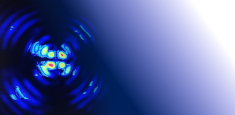Research
The hybrid quantum photonic devices (hqpd) laboratory at the University of Paderborn focuses its research on the realization of building blocks for photonic quantum technologies. The use of state-of-the-art nanotechnologies enables the fabrication of devices down to the nanoscale. Our hybrid and heterogeneous integration approach allows us to harvest the best properties of different material platforms. For example, by carefully designing the structures on our photonic integrated circuits, we strive to realize ideal quantum light sources, active circuit elements, and quantum memories for applications in quantum communication and photonic quantum computing. Our research activities can be categorized in three main pillars: quantum optics experiments, quantum photonic integrated circuit fabrication, and ultra-fast cryogenic electronics.
Our Research Areas

Our quantum optics laboratories are equipped with different continues wave and pulsed laser sources, cryogenic photonic probe stations, cryogenic confocal microscopes, and single photon detectors to investigate solid-state quantum light sources, quantum memories, and quantum photonic integrated circuits. Several advanced measurement setups are home-made, such as transmission spectrometers, phase-stabilized Mach-Zehnder interferometers, and Fabry-Pérot interferometers to perform state-of-the-art quantum optics experiments.
Our group's research heavily relies on nanofabrication, either in our own small fabrication facility in the A building or in the common cleanroom in the P8 building. A key factor in for these research activities are numerical optimization of our devices, for which we use state-of-the-art software solutions. Using electron beam and laser lithography system we define our nanostructures, such as photonic circuits, and use different wet and dry-etching methods to fabricate our devices.
Based on the long-lasting expertise at Paderborn University our group designs ultra-fast cryogenic electronic circuits as on-chip switches, coherent control, and read-out electronics. These circuits are first simulated and designed and later integrated into our quantum optics experiments and serve as a building block of our quantum photonic integrated circuits. We focus on coherent optoelectronic control of quantum systems, ultra-sensitive photocurrent readout as well as fast feed-forward operations.
